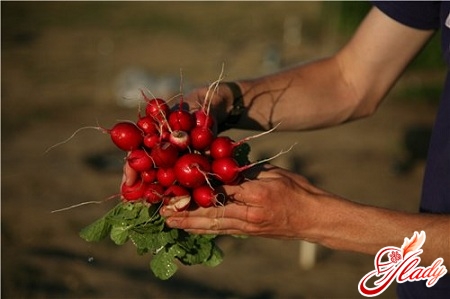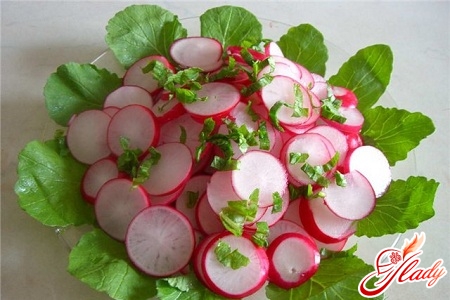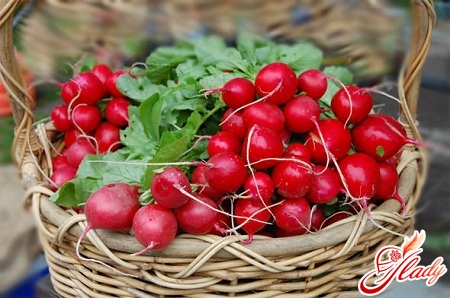 Radish is the very first, and therefore the most popularspring vegetable. The value of radish is due not only to the fact that it has a high content of a number of essential elements and vitamins, but also to the fact that radish is one of the first to bring these vitamins to people, giving the opportunity to restore the body's reserves after a long winter. Radish, or as this vegetable is colloquially called, radish, the cultivation of which is not particularly difficult, was brought, according to legend, from China by the traveler Marco Polo. From Venice, where he brought it, radish has already spread throughout Europe, from where it came to Russia, by personal order of Peter I. Radish is famous not only for its food, but also for its healing properties. It perfectly removes toxins from the body and, which is important for people who are overweight, breaks down fats. Radish opens the season of early spring vegetables. It is also the earliest ripening of the root crop family. But radish varieties are so diverse in growing methods and ripening times that this allows you to have fresh radish on the table all year round. European radish is the earliest ripening - it ripens within twenty to twenty-five days. Among the varieties, the following stand out: "Early Red", "Deca", "Goddess", "Ice Icicle", "Heat", "Dawn", "French Breakfast", "Basis" and others. The roots of these varieties weigh 7-20 grams, and the shape varies from round to elongated. The color is also very diverse - from white and yellow to pink, red and purple. Radish contains a large number of mineral salts of potassium, calcium, magnesium, phosphorus and iron, which are easily absorbed by the body. Radish is also rich in vitamins: it contains B vitamins, enzymes, ascorbic acid and organic acids. Radish is a cold-resistant, but very light-loving plant. Radish seeds begin to germinate at 2-3°C, and the shoots can withstand even light frosts - up to -2-3°C. Grown plants are not afraid of short-term frosts and up to 4-5° below zero. However, the optimal temperature for growing radishes is +16-18°C. Growing early radishes begins in late February - mid-March, when they are sown in greenhouses. Sowing radishes, which are grown under film shelters, begins at the end of March. Under normal conditions, sowing radishes can begin in mid-April, as soon as the first opportunity to work in the garden appears. Using the technology of growing radishes under film, the harvest can be obtained two weeks earlier.
Radish is the very first, and therefore the most popularspring vegetable. The value of radish is due not only to the fact that it has a high content of a number of essential elements and vitamins, but also to the fact that radish is one of the first to bring these vitamins to people, giving the opportunity to restore the body's reserves after a long winter. Radish, or as this vegetable is colloquially called, radish, the cultivation of which is not particularly difficult, was brought, according to legend, from China by the traveler Marco Polo. From Venice, where he brought it, radish has already spread throughout Europe, from where it came to Russia, by personal order of Peter I. Radish is famous not only for its food, but also for its healing properties. It perfectly removes toxins from the body and, which is important for people who are overweight, breaks down fats. Radish opens the season of early spring vegetables. It is also the earliest ripening of the root crop family. But radish varieties are so diverse in growing methods and ripening times that this allows you to have fresh radish on the table all year round. European radish is the earliest ripening - it ripens within twenty to twenty-five days. Among the varieties, the following stand out: "Early Red", "Deca", "Goddess", "Ice Icicle", "Heat", "Dawn", "French Breakfast", "Basis" and others. The roots of these varieties weigh 7-20 grams, and the shape varies from round to elongated. The color is also very diverse - from white and yellow to pink, red and purple. Radish contains a large number of mineral salts of potassium, calcium, magnesium, phosphorus and iron, which are easily absorbed by the body. Radish is also rich in vitamins: it contains B vitamins, enzymes, ascorbic acid and organic acids. Radish is a cold-resistant, but very light-loving plant. Radish seeds begin to germinate at 2-3°C, and the shoots can withstand even light frosts - up to -2-3°C. Grown plants are not afraid of short-term frosts and up to 4-5° below zero. However, the optimal temperature for growing radishes is +16-18°C. Growing early radishes begins in late February - mid-March, when they are sown in greenhouses. Sowing radishes, which are grown under film shelters, begins at the end of March. Under normal conditions, sowing radishes can begin in mid-April, as soon as the first opportunity to work in the garden appears. Using the technology of growing radishes under film, the harvest can be obtained two weeks earlier.
Sowing
You can grow radishes on that piece of land,which is then intended for growing tomatoes. It can be sown until the twentieth of May, almost every week. This will allow you to not only collect a good harvest, but also prepare the soil for planting the next crop. It is better to sow seeds in rows to a depth of up to two centimeters. If you sow radishes deeper, the root crop may not set. The distance between the rows should be 8-10 cm. In this case, approximately 15 g of seeds can be planted per square meter, which is 1.5-2 thousand seeds. It should be borne in mind that growing radishes during the period when daylight hours are already more than twelve hours is undesirable. Despite the fact that radishes develop faster, they often shoot up, and the root crops become small, bitter, woody. Therefore, the optimal time for sowing radishes is early spring or the second half of summer. In order for radish seeds to germinate well, they should be sown in soil that has been previously watered. When the seedlings have their first true leaf, they should be thinned out, leaving a distance of two to three centimeters between the plants. Many novice gardeners fail to get good radish harvests precisely because of untimely thinning. But experts say that it is better to initially sow one seed at a time, since thinning can damage the root of the remaining plant, and it may then grow worse or even form shoots. It should be sown so that the distance between plants is 5 x 5 cm.
Cultivation and care
Technology of growing radishes and caring for themvery simple - loosening, weeding, watering. Since this plant is very moisture-loving, it should be watered, especially in dry weather, twice a day - in the morning and in the evening. In this case, the radish grows dense and juicy. When the plant does not have enough moisture, its root crop, if it is formed, grows hollow and rough, and the plant itself immediately puts out shoots. On cool and cold days, radishes should be watered moderately and rarely. With the onset of warmth, watering is replaced by abundant and frequent. In dry and hot weather, the weekly watering rate for radishes should be 10 l / sq. m. Radishes especially need moisture when the first true leaf appears, and the root crop begins to form. If the weather is dry, you can not keep the radish without moisture for more than three hours, otherwise it will begin to develop incorrectly in the future. Without watering, your radish will grow tough and bitter. But excessive watering also leads to some problems. In this case, the radish will start to crack. As we have already said above, radishes become small and tasteless when grown during long daylight hours. To avoid this, in summer, to reduce the length of daylight hours, you can make screens from black film. To obtain early radishes, it is advisable to grow them in hotbeds, greenhouses or under film shelters. Sowing is carried out at a time determined by the design of the hotbeds and weather conditions. Many gardeners have hotbeds on their plots, the heating of which depends on solar insolation, and the sowing time in them usually falls on the first or second decade of April. To speed up the emergence of seedlings, the seeds can be germinated before sowing.
The soil
Radish, in principle, is not demanding in terms of composition.soil, but it grows especially well on organically rich, loose soil with a slightly acidic or neutral reaction. Cold and heavy clay soils, as well as sandy light soils, are not suitable for growing this root crop. In order to grow radishes on such soils, you need to add humus to them at the rate of 20-30 kg per 10 sq. m. In the garden bed where you intend to sow radishes, the soil should be prepared in the fall. To do this, it must be treated with an aqueous solution of the drug "Baikal EM-1", dissolving it in a ratio of 1:100. The consumption rate of the solution is 2-3 l / sq. m. Radish has high growth energy, so it requires enhanced nutrition and responds to organic fertilizers. Therefore, it is good to add compost to the bed intended for radishes in the fall. By the way, in such a bed, due to the activity of microorganisms, the snow will melt earlier than anything else in the spring. Spring treatment should be carried out when the soil warms up to at least 10°C. Planting radishes should begin no earlier than seven days after soil treatment. Radishes can be planted in places where such crops as tomatoes, cucumbers, peas, potatoes, beans, and beans grew. Fresh manure should not be added to the soil - in this case, the radish will be hollow inside. It should be fed only with rotted organic matter. Please note - if the soil lacks nitrogen, the plant's leaves turn yellow, the radish does not form roots and tops well. This problem can be solved by using complex fertilizers with a high nitrogen content. If the root crop does not set, and the leaves look normal, then there is not enough potassium in the soil. In this case, potassium fertilizers should be added. Radishes are harvested selectively, as they ripen. The first harvest of early varieties begins twenty to twenty-three days after the first shoots appear, and of mid-early varieties - approximately four to four and a half weeks later.
Diseases and pests
Radishes cannot be grown in acidic soils either.because there the radish is affected by a viral disease - clubroot, in which growths appear on the root part of the fruit. It is better not to use such root crops, but to destroy them. In late May - early June, when all the living creatures wake up, the radish can be damaged by the cabbage fly and cruciferous flea beetles. Because of this, small "ulcers" appear on the root crops. Pollinating the radish leaves with ash, garlic infusion or tobacco dust helps to avoid this misfortune. Cruciferous flea beetles can destroy radish crops even before the shoots appear. To prevent damage from them, you need to ensure that no weeds appear in the beds. In addition, frequent loosening and sprinkling of the soil should be carried out. In May-June, the cabbage fly lays eggs on the stem, or on the ground near the radish stem, from which larvae appear in about a week, gnawing through the root crops. The following repellent mixture is used against these pests: 100 g of tobacco dust, 100 g of wood ash and 1 teaspoon of ground pepper. It is added between the rows, after which the soil is loosened every three to four days to a depth of two to three centimeters.
Helpful Tips
We recommend reading:









